MIDI beats 2: Seven rhythms songwriters use for the perfect beat
Still searching for the perfect beat to your song? Let's examine some popular drumbeats that have been used to great success. No matter what genre you’re after, there tends to be a “go-to” pattern.

Still searching for the perfect beat to your song? Look no further.
Today we’ll examine some popular drumbeats that have been used to great success. No matter what genre you’re after, there tends to be a “go-to” pattern. Once we understand the characteristics of grooves, then we can start getting creative with them. So, without further ado, let’s get started.
1. The “money beat” (pop)
Boring? Maybe, but there’s a reason why it’s called the money beat! Songwriters have used this basic beat for decades because it works for so many songs. If you want to write a pop tune, I suggest using this as a template. Start simple, then switch it up – add or subtract notes, change the tempo and use fills. All of a sudden, the “boring” beat could soon become the perfect one. The same goes for all these beats. Try using them as a template, then you can create your own by editing the MIDI notes. This way, you won’t be “copying” everyone else.
Features:
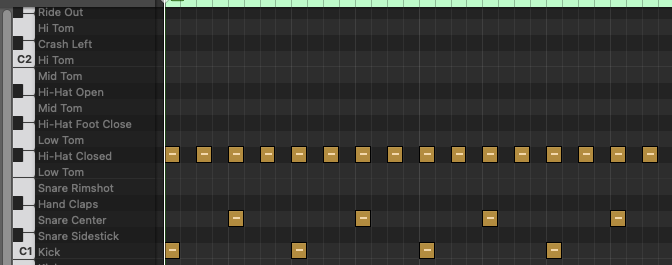
Kick on the 1 & 3, snare on the 2 & 4. 8th notes on the hats (1 & 2 &).
2. The *updated* “money beat” (contemporary/top 40)
Fancy something a bit more trendy? This kick & snare rhythm has been used by everyone in the last few years including Travis Scott, Juice Wrld, Lil Nas X and Cardi B. Imagine all the hits and you’ll soon recognise it. Again, many other top artists have used this blueprint for their songs to great effect. Click here for some examples.
The concept is to use bass drums on the “ands” or upbeats, as this gives the groove a push/pull effect. It’s ideal for any song that has a laidback or danceable vibe.
Features:
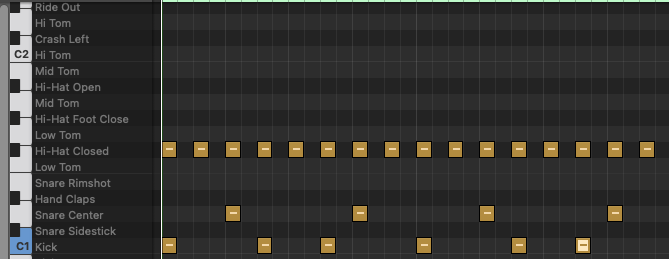
Kick on the 1 + the “and” of 2 & 3, snare on the 2 & 4.
3. The Amen Break (rap/drum n bass)
As I mentioned in a previous article, the Amen break is the most sampled drumbeat of all time. It’s been used by everyone from N.W.A to Oasis, proving it can cross over multiple genres. It uses 16th notes to add texture, including two 16th-note bass drums which command the listeners' attention at fast speeds.
At slow or medium tempos, it’s great for rap songs. Once you speed it up, it becomes a killer beat for many Drum & Bass tunes.
Features: it’s too complicated to explain in words – see the notation or copy the MIDI arrangement:
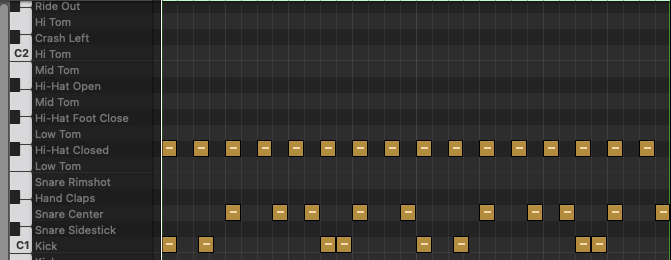

4. Four on the floor (the dance/EDM beat)
This timeless classic does what it says on the tin. Four bass drums on every four beats give this groove its driving force. To the listener, four-to-the-floor grooves are usually felt more than heard. From ABBA to Calvin Harris, from Pitbull to the Bee Gees, artists from every decade have used this rhythm to fill the dancefloor. Keep the kick pattern and experiment with the hi-hat & snare to discover a plethora of different vibes.
Features: Kick on the 1, 2, 3 & 4, Snare on the 2 & 4.
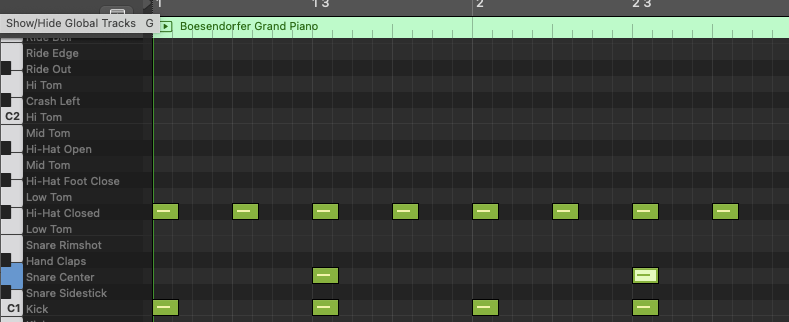
Hi-hat variations:
Dance/reggae - 8thnote offbeats (open/accented hat on every “and”).
Disco - 16th notes (1 E & A) adding some open notes.
5. The Latin beat/Dem-Bow
If you want a simple beat that will make people dance, look no further than this one. It’s been used in all the top Latin songs such as Despactio (Luis Fonsi), Bailando (Enrique Inglesias), Chantaje (Shakira) and Mi Gente (J Balvin). Most of these songs loop the bass drum and snare, and then use the hi-hats or percussion sounds to add more texture.
The key feature is the offbeat before the downbeat on “2”. It gives the rhythm a slight push, which creates a danceable feel synonymous with the genre. The two most used variations of the beat both used the offbeat on the “a” of 1. One opts for a snare, while the other uses the kick.
Variation 1:
Kick on 1 & 3 + the “a” of 1 & 3, snare on the “and” of 2 & 4.
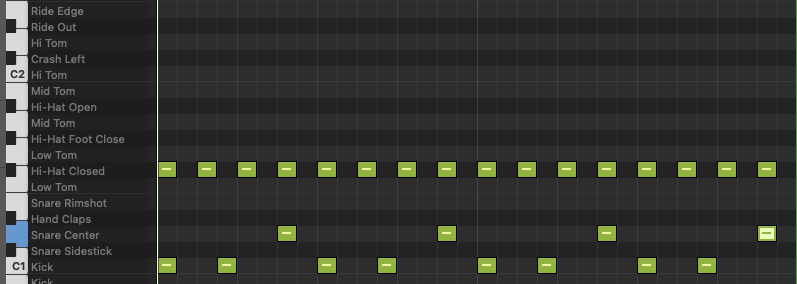
Variation 2:
Kick on all four, Snare on the “a” of 1 & 3 + “and” of 2 & 4.

Variation 3: The Dem-Bow
A staple for Reggaeton artists, the Dem-Bow rhythm is a popular variation that's been used in songs like Shape of You (Ed Sheeran) and Savage Love (Jason Derulo). It was popularised by Shabba Ranks on the song "Dem Bow," using the additional percussion features to great success. Below you can see the broken-up 16th-note percussion accompaniment, played on the edge of a snare drum.
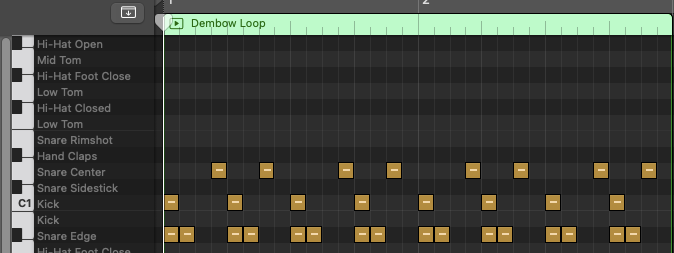
6. Impeach the president (the hip-hop beat)
Arguably the go-to beat for hip-hop artists, this is another infectious groove that’s been sampled hundreds of times. There’s enough flavour, but also enough space to breathe. The open hi-hat provides a nice change in tone and the syncopation spices up the feel. If you want something to get people moving, it’s the perfect beat.
Named after the song which popularised the pattern, Impeach the President can be easily used in funk, soul or dance. See my previous article on the most sampled beats for more like this.
Features:
Kick on the 1, the “a” of 2, 3, & the “and” of 4, Snare on the 2 & 4.
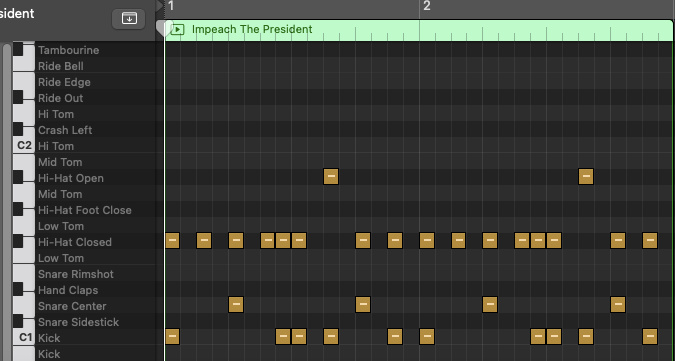
7. The half-time beat (any)
From uber-heavy breakdowns to laid-back RnB tunes, the half-time beat is another versatile rhythm for songwriters. If your song needs space and you want to change the feel, this simple alteration is a game changer.
It could be as easy as moving the snare from the “2” to the “3”, without changing much else from your original beat. Here’s a common half-time beat used in many metal breakdowns:
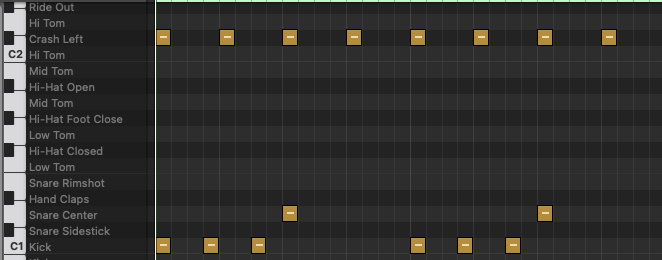
Features:
Quarter note crash/hats (1 2 3 4), bass drum on 1, “a” of 1 + “and” of 2, snare drum on 3.
So, there you have it. The main thing that many songs keep the same is the kick and snare pattern (bar the odd accent or ghost note). After that, artists often layer over different hi-hat or percussion patterns to provide some finesse. Whatever your style, there’s always a blueprint to start with. Have the courage to mess around and change a few notes, then you could be onto a winner.
Best of luck & happy songwriting!
